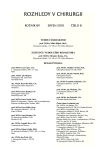The Management of Restenosis Following Segmental Resection for Postintubation Tracheal Injury
Authors:
T. Krajč; M. Janík; M. Lučenič; R. Benej; S. Haruštiak
Authors‘ workplace:
Klinika hrudníkovej chirurgie SZU a FNsP Bratislava, Slovenská republika
prednosta: prof. MUDr. Svetozár Haruštiak, CSc.
Published in:
Rozhl. Chir., 2010, roč. 89, č. 8, s. 490-497.
Category:
Monothematic special - Original
Overview
Aim of study:
In dealing with benign tracheal stenosis, segmental tracheal resection yields superior results in experienced hands when properly indicated, timed end executed. Several factors may contribute to early or delayed failure of resectional treatment. In our retrospective study we analyze the potential causes of tracheal restenosis in patients who underwent segmental tracheal resection for benign tracheal stenosis between 1995–2009 and propose an algorithm for prevention and treatment of such complication.
Patients and methods:
Between 1995–2009, of 249 patients with benign tracheal stenosis 169 underwent segmental tracheal resection with zero perioperative mortality. Of 9 serious anastomotic healing complications (5.3%) we experienced 2 partial and 1 complete anastomotic dehiscence, and 6 serious restenoses (3.6%). Another 2 patients with restenosis were referred from other hospitals. Four patients had a T-tube implanted, of these in 2 it was possible to restore airway continuity by means of a successful parastomic implantation of perforated rib cartilage and tracheoplasty. Two early and two delayed restenoses were dealt with by segmental re-resection. One of our patients with partial anastomotic dehiscence after first tracheal resection underwent a rib-cartilage tracheoplasty after initial T-tube insertion. Subsequently a slowly progressing restenosis had been treated by re-resection after 2 years of observation and worsening symptoms.
Results:
In the patient with complicated history described above the long-term result of treatment continues to be uncertain. In the remaining 4 patients (80%) both anatomical and functional results of re-resection have been favourable even after a very long period of time (8-16 years).
Discussion:
In the paper we analyze the causes of restenosis after segmental tracheal resection and propose an algorithm of restenosis treatment. We consider insufficient assessment of resected segment length and subsequent anastomosis construction in inflamed tracheal tissue to be the most important cause of early restenosis. The late restenoses in our experience were caused by excessive anastomotic tension and possibly by other factors, such as steroid medication. Indication and timing of re-resection depend also on identifying the cause of restenosis. Early restenoses possibly induced by technical error may be treated by reresection sooner than delayed restenoses, which usually require 6-12 months for inflammatory changes to subside. In both scenarios T-tube insertion represents a reliable temporary or even permanent solution.
Key words:
restenosis – re-resection – segmental tracheal resection – benign tracheal stenosis
Sources
1. Grillo, H. C. Development of tracheal surgery: a historical review. Part 1: techniques of tracheal surgery. The Annals of Thoracic Surgery, 75, 2003, č. 2, s. 610–619.
2. Grillo, H. C. Development of tracheal surgery: a historical review. Part 2: treatment of tracheal diseases. The Annals of Thoracic Surgery, 75, 2003, č. 3, s. 1039–1047.
3. Donahue, D. M., Grillo, H. C., Wain, J. C., et al. Reoperative tracheal resection and reconstruction for unsuccessful repair of postintubation stenosis The Journal of Thoracic and Cardiovascular Surgery, 114, 1997, č. 6, s. 934–939.
4. Grillo, H. C. Complications of tracheal reconstruction. In: H. C. Grillo (zostavovateľ) Surgery of the trachea and bronchi. Hamilton, Ontario, USA: BC Decker Inc, 2004, s. 483–497.
5. Wright, C. D., Grillo, H. C., Wain, J. C., et al. Anastomotic complications after tracheal resection: Prognostic factors and management. The Journal of Thoracic and Cardiovascular Surgery, 128, 2004, č. 5, s. 731–739.
6. Grillo, H. C., Donahue, D. M., Mathisen, D. J., et al. Postintubation tracheal stenosisTreatment and results. The Journal of Thoracic and Cardiovascular Surgery, 109, 1995, č. 3, s. 486–493.
7. Abbasidezfouli, A., Akbarian, E., Shadmehr, M. B., et al. The etiological factors of recurrence after tracheal resection and reconstruction in post-intubation stenosis. Interactive CardioVascular and Thoracic Surgery, 9, 2009, č. 3, s. 446–449.
8. Haruštiak, S. Zkušenosti s chirurgickou léčbou trachey. In: M. Hájek, J. Drábková, S. Haruštiak, M. Marel a J. Vomela (zostavovatelia), Kritická onemocnění průdušnice a jejich léčení. Praha: Grada Publishing, 2000, s. 97–109.
9. Krajc, T., Janik, M., Benej, R., et al. Urgent segmental resection as the primary strategy in management of benign tracheal stenosis. A single center experience in 164 consecutive cases. Interactive CardioVascular and Thoracic Surgery, 9, 2009, č. 6, s. 983–989.
10. Haruštiak, S. T-kanyla v liečbe tracheálnych stenóz. In: P. Pafko a S. Haruštiak (zostavovatelia), Praktická chirurgie trachey. Praha: Galén, 2001, s. 105–111. 10
11. Pereszlenyi, A., Igaz, M., Majer, I., et al. Role of endotracheal stenting in tracheal reconstruction surgery—retrospective analysis. European Journal of CardioThoracic Surgery, 25, 2004, č. 6, s. 1059–1064.
Labels
Surgery Orthopaedics Trauma surgeryArticle was published in
Perspectives in Surgery

2010 Issue 8
Most read in this issue
- Syndroma Caudae Equinae of Rare Etiology
- Possibilities and Results of Surgical Treatment of Benign Tracheoesophageal Fistula
- How Long to Wait with Operations for Necrotizing Pancreatitis?
- Urgent Thyroidectomy for a Mechanical Syndrome Caused by a Toxic Nodular Goiter – A Case Report
